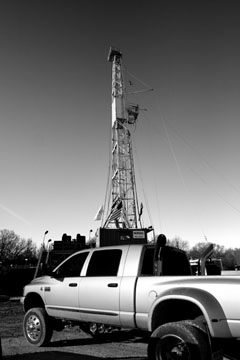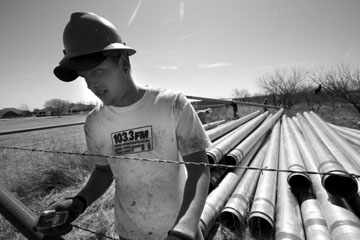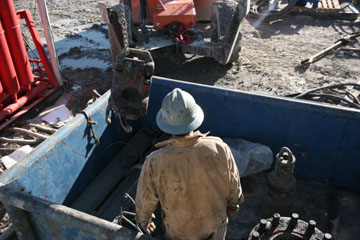 But the buyers, for the most part, don’t drive up in BMWs or Mercedes, and they’re not wearing suits either. “Ever since the boom in gas drilling started, we’ve got these young blue-collar guys with name tags on their shirts coming in every payday and putting down $139 for a bottle of Remy Martin XO or $79 for 18-year old Bushnell’s” – or the $100 Patron, said saleswoman Shelly Marquis. It’s liquor that “they could no more have afforded a couple of years ago than I could now.”
But the buyers, for the most part, don’t drive up in BMWs or Mercedes, and they’re not wearing suits either. “Ever since the boom in gas drilling started, we’ve got these young blue-collar guys with name tags on their shirts coming in every payday and putting down $139 for a bottle of Remy Martin XO or $79 for 18-year old Bushnell’s” – or the $100 Patron, said saleswoman Shelly Marquis. It’s liquor that “they could no more have afforded a couple of years ago than I could now.”
Vernon Russell, owner of the liquor store off I-35 at Felix Street, heard the conversation and joined in. “I’ll tell you something about this boom,” he said. “I got a friend with a car dealership, and he says these boys are buying diesel trucks as fast as they come onto his lot. And they’re all going to guys working the gas field.” Nothing epitomizes the world of boom ‘n’ bust like a gold rush or oil strike. Workers who were standing on street corners looking for day labor one day can find themselves on Easy Street the next – and probably back on the corner nearly as quickly, since money has a way of burning a hole in a poor man’s pockets.
In North Texas today, nothing is making millionaires out of nearly bankrupt farmers and a new upper-middle class out of formerly out-of-work truckers and oil riggers more quickly than the Barnett Shale. Jobs are there for the asking, the pay is better than good, the benefits make the risk worthwhile, and the future is fueled with natural gas … at least for the moment.
Two years ago, Clint Stephens wasn’t sure what the future held. The tall and lanky ex-Marine with Marlboro Man looks had graduated from Joshua High School in 2004, joined the Marines, and shipped out to Iraq less than three months later. He served nine months there, and when he came back, the Marines wanted him to go to sharpshooter school. But injuries to his back and a knee, suffered in training, ended his tour early. Back in civvies, he quickly discovered that being a former Marine with nine months in Iraq under your belt made it tougher, not easier to get a job. “People thought I must be crazy or that I might go crazy or something. I don’t know. All I know is nobody wanted to hire me when they heard I served as a Marine in Iraq.”
And then came the Barnett Shale. Now Stephens, 22, is laying pipe, helping move the gas from wells to distribution points. “Nobody cares what you did [before],” he said. “They don’t care about your education, your past, or even if you went to war. All they care about is if you can work hard. “I’m working as much as I want, I’m getting paid and staying out of trouble, and I’m going to buy a house next year with money that I earned,” he said. “How many 22-year-olds do you know who can say that? “I’m in redneck heaven.”
 The largest gas company working the Barnett Shale is Devon Energy, which has produced roughly 25 percent of all the wells in the region. Devon itself has only about 500 employees, but a 2005 economic impact study the company commissioned concluded that Devon was “supporting” 8,800 jobs worth $411 million in wages, salaries, and benefits at that time. Those figures have grown tremendously in the intervening years as the Barnett drilling boom continues. But even those 2005 numbers suggest that more than 35,000 people in this part of the country are earning a living directly off the Shale. A more recent study, quoted by a consortium of Barnett Shale companies, suggests the boom has created more than 55,000 new jobs – in retail and home-building industries as well as in the gasfield – and will spur creation of another 53,000 jobs in the next 10 years. Some of the jobs are dangerous; many include long hours of overtime doing rough work in all weather. But others are no more strenuous than reloading those shelves at the Two Bucks.
The largest gas company working the Barnett Shale is Devon Energy, which has produced roughly 25 percent of all the wells in the region. Devon itself has only about 500 employees, but a 2005 economic impact study the company commissioned concluded that Devon was “supporting” 8,800 jobs worth $411 million in wages, salaries, and benefits at that time. Those figures have grown tremendously in the intervening years as the Barnett drilling boom continues. But even those 2005 numbers suggest that more than 35,000 people in this part of the country are earning a living directly off the Shale. A more recent study, quoted by a consortium of Barnett Shale companies, suggests the boom has created more than 55,000 new jobs – in retail and home-building industries as well as in the gasfield – and will spur creation of another 53,000 jobs in the next 10 years. Some of the jobs are dangerous; many include long hours of overtime doing rough work in all weather. But others are no more strenuous than reloading those shelves at the Two Bucks.
In Stephens’ case, two years working the Shale have allowed him to get his own apartment and buy a ’98 Dodge 4 X 4 that he’s had raised and outfitted with oversized wheels, along with a pocket-rocket motorcycle and a run-around car for his girl. He’s even been known to buy an occasional bottle of Patron when visiting friends. “But I’m putting most of it away,” he said. “I know how things can change, and I don’t want to be one of those guys complaining that I’ve got nothing when this boom is over. That’s why I want to buy a house – so I’ll have something to show for all the work I’m doing.”
The work often includes 30 or more hours of overtime weekly, which can push his paycheck to nearly $800 a week gross. Stephens is one of the smart ones. Other young men are thinking the Shale might last forever and are spending next month’s paycheck before this month is gone. “A lot of the folks we see are from out of town, and they’re buying cars and trucks and recreational vehicles,” said Mike Ross, sales manager for one of the Lynn Smith Chevrolet dealerships. “We’ve seen a real good spike from everyone involved in the Shale – landowners getting royalties, supply companies needing several trucks at once, small RVs for people who came to this area for work and need a place to stay.”
Overall, he said, he’s seeing three classes of new buyers. “You’ve got the land owner/royalty guy, the well-management guys, and then the blue-collar guys doing the real work. And all of them are buying big-ticket items. “The blue-collar guys especially are buying trucks that go for $40,000 to $50,000. Some of these same guys have bought from us before, and in the past they were buying used trucks. A lot of these guys had nothing three years ago. Now even guys with bad credit are coming in and putting $10,000 or $20,000 down and asking for leather seats and the best sound systems we’ve got.”
All over North Texas, business owners said similar things – spending on sound investments and spur-of-moment luxuries is increasing. Furniture stores are selling better quality merchandise, and four-wheelers and Skidoos are selling wildly. And then, of course, there are the $100 bottles of tequila … and other pleasures. At the topless joints, though none would go on the record, several employees said they’re seeing more and more young guys coming in who used to hold onto a brew for an hour, but now ante up for a lap dance or two. If nothing goes wrong, the thousands of men and women now making $800 to $2,000 a week in connection with the Shale could keep seeing those paychecks roll in for another 20 years. Gas company owners and folks with enough property to produce fat royalty checks likely will walk away from the boom with enough new wealth to change their lives for a long time. But the question for blue-collar workers (and small-time royalty recipients) is whether they will heed the prayer posted in an old construction trailer: “God, give me one more boom,” it said, “and I promise not to waste it this time.”
“Oh, this has definitely been a boon to me,” said an office worker for one of the big rigging companies, the single mother of a 17-year-old. She asked that her name not be used. “In the past I’ve owned two of my own businesses, and I worked at Lockheed for about 10 years, but this has been fantastic,” she said. “I have more stability than I ever had. I came into the gas business knowing nothing, but after less than three years I’ve learned a lot. And I’m earning enough to be taking real estate courses. I could never do that with any of the other jobs I’ve had. The Barnett Shale means a lot to a lot of different people. The people who just see the mess that’s made hate it, but to regular folk it means a living and stability. It means I know where my next check is coming from, and there’s a lot of freedom in that.”
 Raising a daughter alone, she hasn’t had the luxury of buying a new car or running over to Oklahoma or Louisiana for a weekend at the casinos. But she has learned the ropes and can see herself earning a good living for as long as she wants. “This is a boom for the working class, not just the people with 2,000 acres to drill on,” she said. Two Mexican workmen delivering supplies to a Tarrant county well site couldn’t agree more. Neither would give his name, but both said the Shale was the best opportunity they’d ever had. “Before this my partner and me were working in plumbing. We were making good money, about $8 an hour,” one man said. “Now we’re making $15 an hour and working 20 to 30 hours a week overtime. So we’re able to send more money back to our families, and the rest goes into the bank.”
Raising a daughter alone, she hasn’t had the luxury of buying a new car or running over to Oklahoma or Louisiana for a weekend at the casinos. But she has learned the ropes and can see herself earning a good living for as long as she wants. “This is a boom for the working class, not just the people with 2,000 acres to drill on,” she said. Two Mexican workmen delivering supplies to a Tarrant county well site couldn’t agree more. Neither would give his name, but both said the Shale was the best opportunity they’d ever had. “Before this my partner and me were working in plumbing. We were making good money, about $8 an hour,” one man said. “Now we’re making $15 an hour and working 20 to 30 hours a week overtime. So we’re able to send more money back to our families, and the rest goes into the bank.”
Nathan Patterson works for Stallion Oilfield Services, which hauls water, moves heavy machinery, and offers a host of other services vital to gas drilling and production. “I was hauling granite for about $9 to $12 an hour. Now I’m making $16 an hour, and with overtime I’m bringing home almost $1,000 a week. I mean, I’m doing 70 hours for that, and I do every bit of it, but it’s worth it.” Patterson started out at Stallion as a driver two years ago but has been promoted to dispatcher. “And we’re looking for 35 new drivers right now – that’s how much work there is.”
He came to the Shale from Royse City, about 35 miles east of Dallas. “I drove 200 miles a day just to work here, and then I moved my family here,” he said. He’s spent some of his earnings on a new Suburban for his wife and has repaired his credit to the point where he’s looking for a house. Patterson said he’s met a lot of fellows in the Shale who’ve bought new Harleys, four-wheel-drive trucks, and even boats. And a lot of the guys, he says, take “real good vacations.” But the fellows he works with are mostly family men, spending their money on buying or upgrading their homes. “You know the best money I made before this?” he asked, then quickly answered: “$11.50 an hour, cleaning port-o-potties. I was headed to nowheres quick, and now my life is back on track. Heck, I’m even trying to talk my friends into coming to work here.”
Like Patterson, Josh Bell, 24, has only a high-school diploma. And like Patterson he’s been working the Shale for just about two years. He loves it. “My company supplies air for directional drilling. You know, the driller takes the hole so far, and then we come in and supply the air for the hammer – the piston – to work.” Bell does 12-hour shifts about 25 days a month. His only days off are when he’s waiting for a rig to get set up. “We’ve got people on the rig from everywhere – Corpus Christi and Louisiana and Oklahoma. And for every rig you see, there are water trucking companies, rig moving companies, landmen who’ve got those leases – my wife works as a landman, and she makes more than me – welders, mechanics, people who clear the site, people who run electric to the site, cement workers, pipe makers and pipe fitters, bolt supply companies, parts companies … man, there’s hundreds of people involved. “And with that many people all making good money – the least you make on the Shale is probably $40,000 – you know you’re gonna run into some guys who can’t hold onto it. You see some $80,000 turbo diesel 350s tricked out like crazy, sure you do. But then most of the guys are buying land and houses, and a lot of it is being spent back where they come from.
“My own money is going to my 2-year-old and my brand-new baby boy,” he said. “We don’t have insurance – most oilfield jobs don’t – and so prenatal care and hospitals can take up a lot. But that’s all right. I’m just glad I have the work to pay those bills.” “Some people will always look for the downside,” said a young guy wearing a hard hat and safety goggles at a rig site just outside Crowley. “Some people say this can’t last, that if there’s a recession and factories stop using natural gas we’ll all be out of work. Well, we might be. That’s why I think it’s crazy to go out and spend 60 grand on a car with a note that runs over $1,000 a month. “But my wife and I have put enough away in two years to go looking for a house. And we’re looking for a house we can buy with cash – I’ve made that much that I can do that. So if it all ends tomorrow – and I don’t think it’s going to end for 10 years – but if it does, well, I’ll have a house bought and paid for. And then I’ll go be a fireman or a policeman or do what everybody else who isn’t working the Shale does. But right now I’m in blue-collar paradise.”
Some people have come out of retirement to scoop up Shale work. “I have one friend who drove a truck his whole life and made good money, probably $45,000 a year,” said Russell, the liquor store owner. “Well, he retired, you know, but after about a year, he went to hauling water for the rigs. He said he couldn’t turn it down. He’s going about $65,000 a year now. Nobody can turn that kind of money down. At least not working-class guys.” Melaina Crocker has it made from the Barnett Shale, but she’s also paying a price. Her husband’s job, as area supervisor for a compressed-air drilling company, is paying more than $10,000 a month, and she’s also got 20 acres in Johnson County that are bringing in royalties of several thousand a month. But the stress on her husband from being on call 24/7 recently put him in the hospital with congestive heart failure.
“My whole family’s from Louisiana and in the oil business, so I grew up in the oilfields,” she said. “And I’ve lived through a boom and seen it bust too. But when it looked like the Shale was going to become a big play, I bought 10 acres with full mineral rights out in Cleburne. And then I bought the mineral rights for another 10 acres from a neighbor who didn’t want anything to do with them. And then, of course, I got lucky.” With the royalties from her share of the well, she and her husband paid off their mortgage, bought cars with cash, then built a new house, also paid for with cash. “I do have a note on a pool I had put in, but that shouldn’t take long to pay off,” she said. She’s also put money away for her children’s college. “We’re not splurging, but we are living like people should be living,” she said. “I mean, I was able to quit my job and stay home with my family. That’s not asking too much. And we can afford a cruise now and then, or a trip to Vegas, or just a nice meal at a restaurant when we don’t feel like eating at home.
“Of course, some of the guys, when they run into money, they just waste it. I know a lot of people in Louisiana who should be millionaires, but instead, they’re broke. I’m more of a middle-of-the-road person: I want to enjoy every day, but I also put some money away, because I know that every boom sooner or later goes bust.” Her husband James was one of those who had a perfectly fine job – he worked as a master mechanic for Chrysler – but answered the call of more money in the Shale. His experience points up another side of the Shale boom – the way it’s sucking workers and business from other industries.
One of the few people interviewed for this story who wasn’t happy with the Barnett Shale was a spokesman for A & G Piping Inc., a major firm whose company does pipe fitting for clients that include the Miller brewery, Alcon Laboratories, Baylor Medical Center, and Dallas/Fort Worth International Airport. “We’ve lost a lot of experienced welders to the Shale,” he said. “A lot of our guys went out and bought their own trucks and welding equipment and are now working as independent contractors for the drilling companies.” Why would they do that?
 “The money. They were probably looking at $22 an hour with us, but now they’re making around $50 an hour, and they’re working 60-hour weeks.” Another person unhappy with the Shale is Shirley Chambers, who with her husband had a gravel-hauling business that was laying gravel for Barnett Shale rigs as early as 2002. “It’d take about six of us owner-operators to lay one of those rig pads. And you know, you had to know what you were doing, because if anything shifted, that rig was going to come down. But then when the money got real good, a big company came in and underbid us, and we were out. No notice, just out of work. “After that I put together a water-hauling truck and began moving well-waste water. And at the beginning that was real good money. I was getting $95 an hour for the truck and driver. But then again, in came a big company, and the rate dropped to $65 an hour, and with diesel prices sky-high, it wasn’t worth it anymore. I finally sold my truck. I just couldn’t compete with a big company.”
“The money. They were probably looking at $22 an hour with us, but now they’re making around $50 an hour, and they’re working 60-hour weeks.” Another person unhappy with the Shale is Shirley Chambers, who with her husband had a gravel-hauling business that was laying gravel for Barnett Shale rigs as early as 2002. “It’d take about six of us owner-operators to lay one of those rig pads. And you know, you had to know what you were doing, because if anything shifted, that rig was going to come down. But then when the money got real good, a big company came in and underbid us, and we were out. No notice, just out of work. “After that I put together a water-hauling truck and began moving well-waste water. And at the beginning that was real good money. I was getting $95 an hour for the truck and driver. But then again, in came a big company, and the rate dropped to $65 an hour, and with diesel prices sky-high, it wasn’t worth it anymore. I finally sold my truck. I just couldn’t compete with a big company.”
But Chambers isn’t entirely missing the Shale. “Tell you the truth, who wants to haul that water that’s contaminated with all sorts of chemicals and radioactive nonsense? And it’s so darned salty, and the salt gets on everything. It’s in your hair, your eyes, under your fingernails. It’s just plain unhealthy. Heck, when it rains and that stuff comes up, it will take the paint right off your personal vehicle. It goes into your truck and burns holes in it, just makes them leak. “But for the guys who came from West Texas and Oklahoma and who knows where, well it’s good for them. Some of those folk were out of work forever. I mean, it’s made it real hard on us independents, what with the glut of trucks out there, but you can’t begrudge a man working.”
It was one of the nastiest days of the year, with icy rain and sleet falling for hours in a howling wind. Out on Nomac 102, a Chesapeake Energy rig working off a country road just south of the Tarrant County line, a roughneck was loading 40-foot casing pipes onto a heavy sleeve armature that was hauling them up into the center of the rig and dropping them into the hole. The tool pusher – rig supervisor Dave Carroll – wouldn’t be specific on the number of days the rig had been drilling or on how deep they’d drilled. “That’s none of your business,” he said in a polite East Texas drawl. If it was true to most of the Barnett Shale experience, he’d probably been drilling about 18 to 20 days and from the number of pipes being run down the hole he’s gone at least 8,000 feet, maybe 12,000.
Didn’t really matter. What mattered was that moving that pipe was nearly an impossible task on a day like that. Heck, just walking in the white clay mud was nearly impossible. It was the kind of day when everyone on the rig earns their money, the kind of day when a lot of people realize they wouldn’t take one of those jobs regardless of size of the paycheck. Most of Carroll’s crew, four teams of five men each, came with him from East Texas, near the Louisiana line. A couple are from the Tarrant area. Carroll, as the lead man on the rig site, lives with the rig. He works seven days on, seven off, on call all the time if need be. The rest of a given crew – there are four on each rig, each working 12-hour shifts, seven days on, then seven days off – is made up of a driller, who operates the equipment; a derrick man, the guy who brings the pipe in and out of the well and oversees the drilling fluid system; and three roughnecks, the guys who handle the pipe and such. Some crews also have a motorman, who takes care of all the motors and the electrical equipment on the rig.
According to Denny Smith, a spokesman for Nabors Drilling USA out of Houston, the tool pusher makes in the range of $80,000 to $100,000 a year, the driller in the $70,000 to $80,000 range, the derrick man between $60,000 and $70,000, and the roughnecks about $50,000. All the other jobs in the oilfield depend on those rigs and those crews working. If the rigs are down, pretty much everything shuts down, which is why a freezing rain doesn’t even slow them down. Carroll, 61, has been in the oilfield since 1964. He’s a big burly guy with a weathered face and hands the size of baseball catchers’ mitts. “I came into it when things were real slow, and I’ve seen a lot of ups and downs,” he said. “And since I’m an old hand, I try to tell some of these kids to put some money away, but sometimes that goes in one ear and out the other. But it’s their money. They do earn it out here, and so they can do what they want with it.”
Not far from him are two big new turbo diesel trucks, both lifted way off the ground and one outfitted with gleaming chrome exhaust pipes rising out of the truck bed. With all that extra work, they’re probably $80,000 vehicles. Carroll doesn’t mention them, but it’s hard to ignore the fact that they cost well over anyone’s entire salary for a year – before taxes. Maybe the owners of the tricked-out trucks figure they have 19 more years of good money coming – about how long most folks think the Barnett Shale field will last. “Usually it’s a rhythm, with the bad times lasting about as long as the good times,” Carroll said. “I’ve never seen the good times last as long as this thing has now. And I hope it does last another 20 years. But that’s up to supply and demand. They’ve sure got the gas down there, and they’ve got everything in place, and it sure would be nice if it lasted. But in my experience it doesn’t. And when the bad times come, well, I’ve gone  to work in machine shops, I’ve laid brick, done electrical work … you name it, and if it’s physical labor, I’ve done it.
to work in machine shops, I’ve laid brick, done electrical work … you name it, and if it’s physical labor, I’ve done it.
“These guys will do the same. They’ll go work in factories or whatever they have to do to put food on the table. But that’s all the other work does. And if you have big notes on things like cars and boats when the slow times come, well, you lose those things. When it’s good times, you’ve got money in your pocket, but there’s no guarantees things won’t change.”
Two days later Nomac 102, its well drilled, was disassembled. Out on the country road there was a regular caravan of 18-wheelers hauling out living trailers, the rig assembly, motors, compressors, tubing, pipes, and tons of unused cement, all heading for the rig’s new location, somewhere in Johnson County. Next month Nomac 102 might be in Fort Worth or Denton or Cleburne. Within a couple of weeks all that will be left at the site will be a couple of water/gas separators on a concrete slab in the middle of a cow pasture.
You can reach Peter Gorman at peterg9@yahoo.com.











